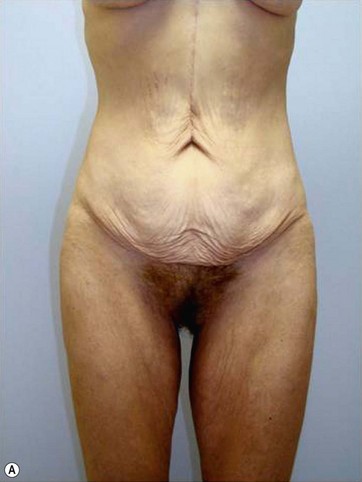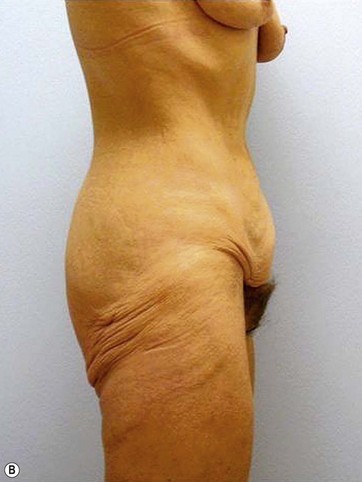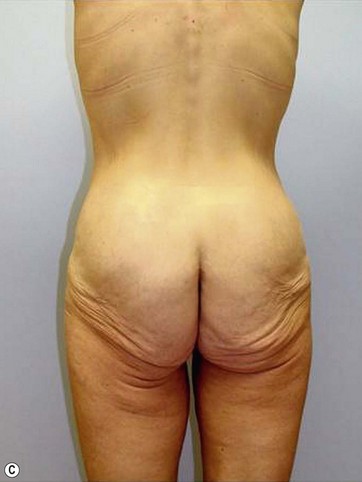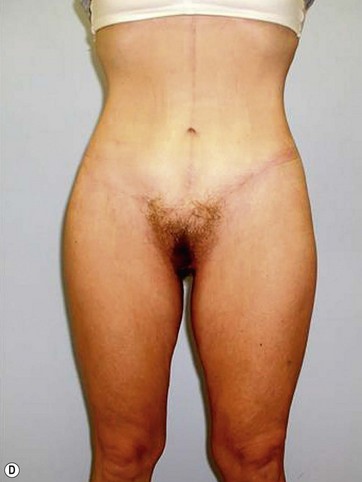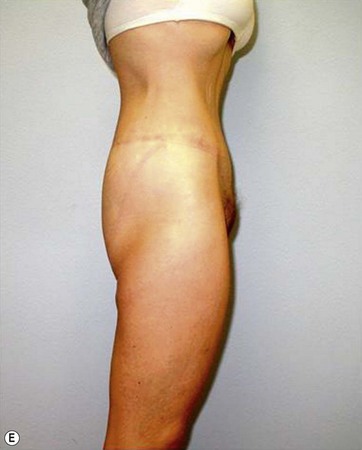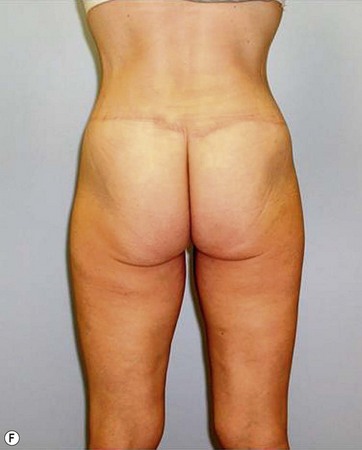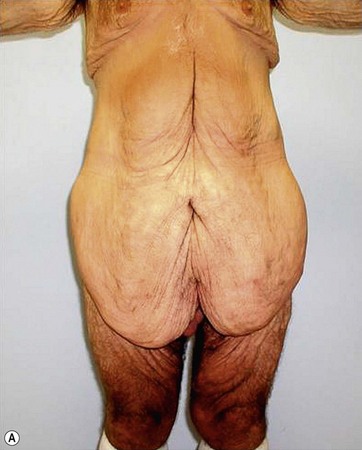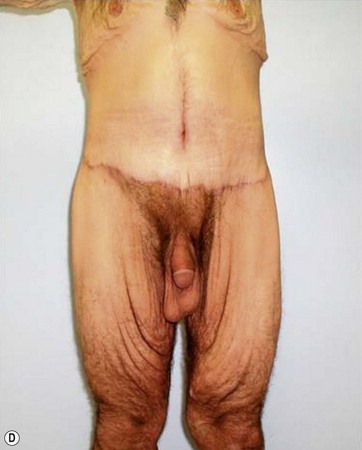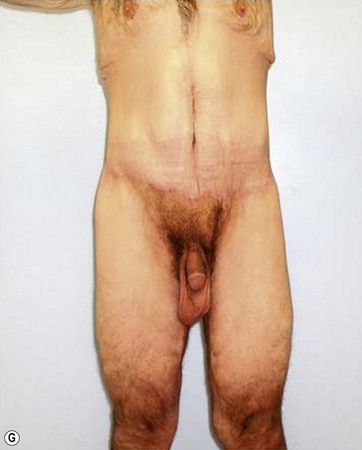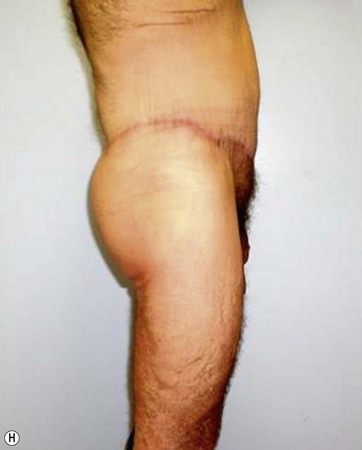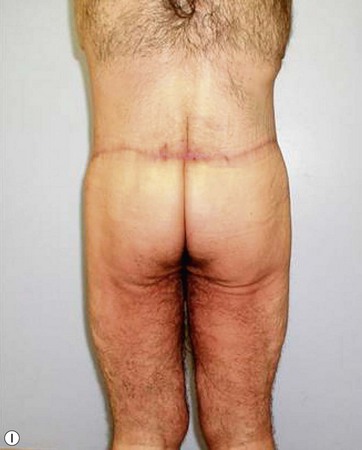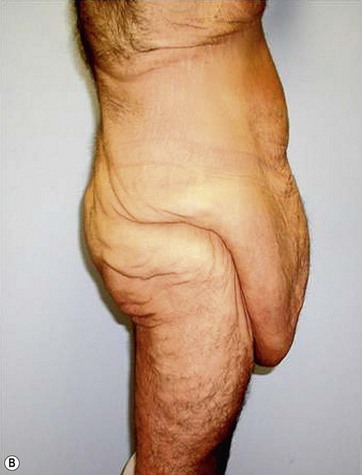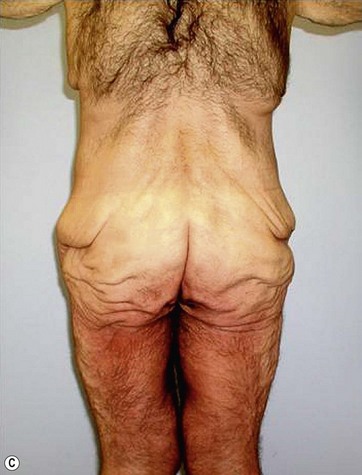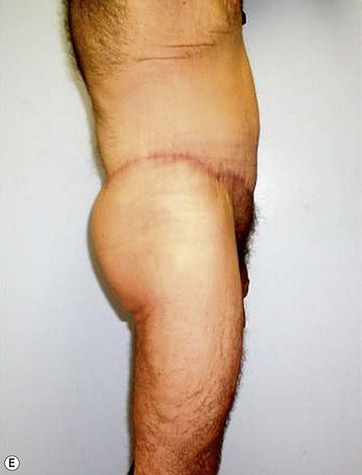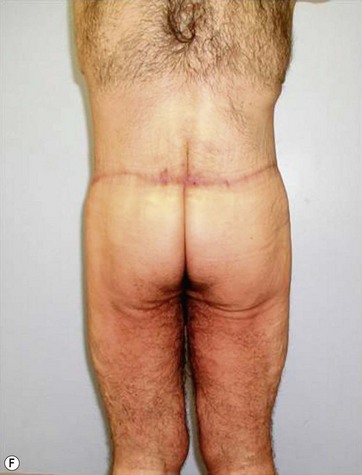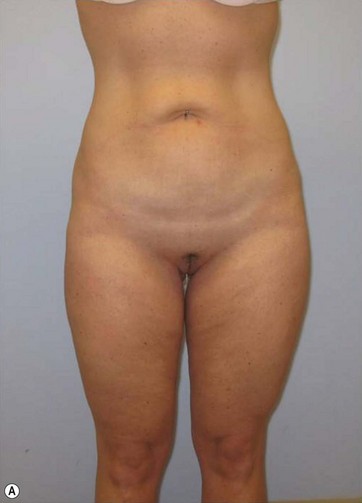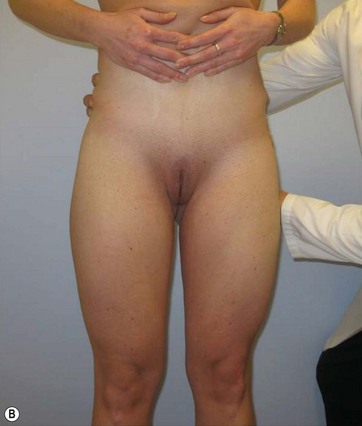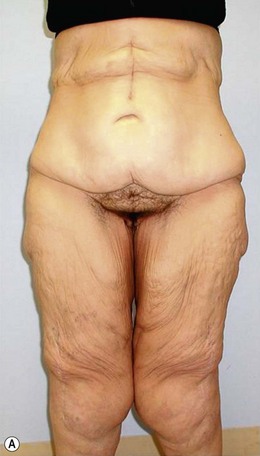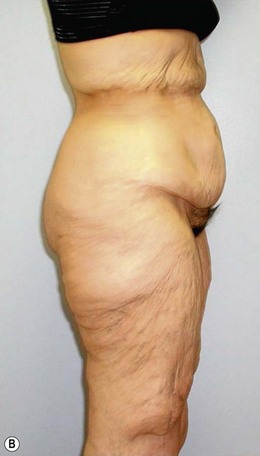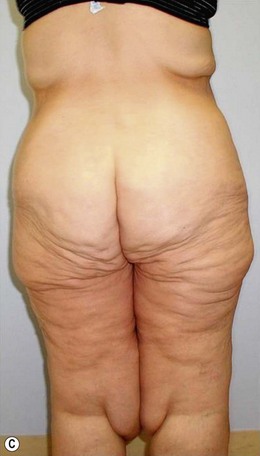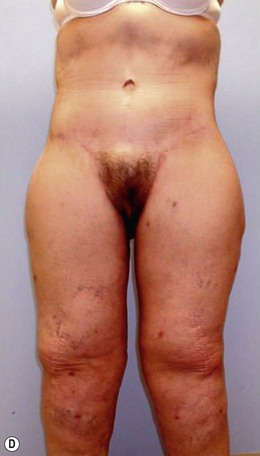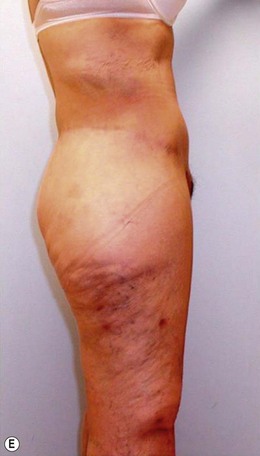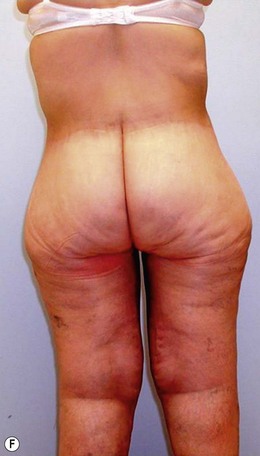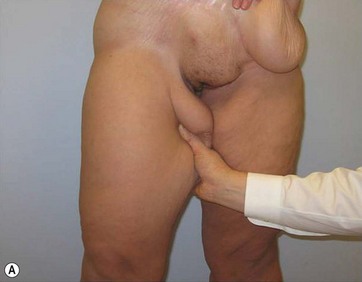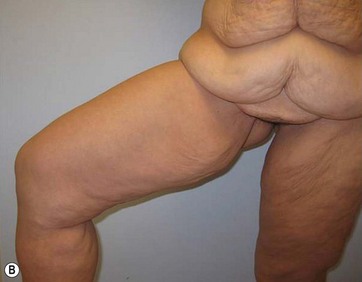Chapter 35 Vertical medial thigh lift with liposuction
• Careful patient screening and education is critical to optimizing the outcome of medial lift procedures.
• Major variables contributing to the medial thigh deformity include descent of the mons pubis, inferomedial migration of thigh soft tissues, descent of the buttocks and circumferential thigh soft tissue excess secondary to weight changes and aging. Prior liposuction may also contribute to thigh contour deformities.
• Correction of soft tissue excess along the abdomen, thighs and buttocks prior to a medial thigh lift is essential for an effective medial thigh lift.
• Thigh lift procedures with an excisional component limited to the thigh perineal crease usually provide little if any additional benefit to individuals who have undergone circumferential body lift procedures.
• Liposuction in vertical medial thigh lift procedures serves to create a readily identifiable and safe plane of dissection and to improve outcome by optimizing the amount of soft tissue that can be removed.
• The combination of a prior lower body lifting procedure and a medial thigh lift with a vertical component helps minimize the likelihood of the well described complications associated with media thigh lifts: labial spreading and scar migration.
![]() For additional online content visit http://www.expertconsult.com
For additional online content visit http://www.expertconsult.com
Introduction
Medial thigh contour deformities are a frequent concern for many individuals seeking body contouring. The deformity is usually secondary to weight loss and often associated with prior pregnancy and, in many instances, liposuction of the thighs. Despite the frequency of this concern, plastic surgeons have often been reluctant to embrace the medial thigh lift procedure because of the risk for significant complications, relatively poor results and the potential for readily visible scars.1–3 Until recently, nearly all medial thigh lift techniques described in the literature attempted to address the medial thigh deformity by removing soft tissue excess in a vertical vector alone. An interesting exception was the first description of a medial thigh lift in 1957 by Lewis.3–14 He advocated both a horizontal and vertical component to the procedure. Lockwood, a proponent of vertical vector excision alone, described minimizing complications such as labial spreading and scar migration and improving outcome by securing the medial thigh flap to Colles’ fascia. While the concept appeared to be a logical approach to address problems associated with medial thigh lifts, it added little to existing procedures. In recent years, primarily in response to the increase in numbers of individuals with post-bariatric body contour concerns, plastic surgeons have once again advocated the excision of soft excess in both a vertical and horizontal vector to address medial thigh deformities.15–19
Our approach to medial thigh contour deformities is to address the variables outside of the medial thighs affecting the medial thighs prior to performing a medial thigh lift procedure. In most instances, a body lift or simultaneous abdominoplasty, thigh and buttock lift is performed first. For a small number of individuals, only an abdominoplasty is performed initially. For some patients, the need for a medial thigh lift may be eliminated altogether by these techniques (Fig. 35.1). For patients with a remaining deformity, a medial thigh lift with a vertical component is performed (Fig. 35.2A, B, C, D, E, F, G–I).15,20–22 For data and discussion purposes, we have classified our various forms of medial thigh lift (Table 35.1).
TABLE 35.1 Classification System for Medial Thigh Lifts
FIG 35.2B, C, E, F Appears ![]() ONLINE ONLY
ONLINE ONLY
Preoperative Preparation
As with all surgical candidates, individuals seeking surgical correction of their medial thigh deformity should undergo a thorough history and physical examination. Information particularly relevant to medial thigh lift surgery includes a history of weight change, whether secondary to bariatric surgery, lifestyle changes or pregnancy. The patient’s height, current weight and maximum weight should be noted as should the time interval between their maximum and current weight. If weight loss was achieved through bariatric surgery, the technique and when it was performed should be noted. For patients who have lost weight through lifestyle changes, some discussion should take place as to how this was accomplished (i.e., exercise, diet and exercise, medication) and whether they are being supervised by a professional.23 Previous body contouring procedures should be noted, including liposuction, as it may impact on a surgical plan and outcome. A history of lymphedema or peripheral vascular disease should also be documented. As part of the initial interview, the patient’s expectations for medial thigh lift surgery and their tolerance for scars should be clearly established.
Physical exam should focus on a careful assessment of the medial thigh deformity and the variables outside of the medial thighs potentially contributing to the deformity: soft tissue excess along the mons pubis, the hips and lateral thighs and buttocks. In an effort to assess the variables contributing to the medial thigh deformity during the examination, patients should be asked to stand in front of a full length mirror and to apply strong upward traction to the soft tissues of their lower abdomen with their two hands. At the same time, the surgeon or examiner should then apply strong upward traction to the patient’s lateral thighs and buttocks. This technique for examination helps eliminate the variables outside of the medial thighs contributing to the medial thigh deformity. It also serves to illustrate for patients the function of circumferential body lifting procedures. Patients usually are not aware of the significance of these variables (Fig. 35.3). A second maneuver that should also be considered is to have patients abduct one their thighs (Fig. 35.4). Grasping the soft tissue of the medial thigh with the patient standing will provide similar information. These techniques highlight soft tissue excess in the horizontal vector, accurately demonstrating the function of the vertical medial thigh lift with liposuction procedure. The distal extent of the thigh deformity should be noted. Many women and some men have concerns about the excess soft tissue along the medial aspect of the knee and in some instances the leg as well (Fig. 35.5).22 Some women may have soft tissue draping the anterior aspect of the knee following extreme weight loss (Fig. 35.6). Tissue elasticity can be assessed by evaluating the skin for the presence of striae and cellulite. The fat content of the thighs and surrounding structures should also be noted. Patients with less fat excess usually have a more “deflated” appearance (Fig. 35.2). Note is made as to whether intertriginous dermatitis is present, potentially along the proximal medial thigh. Lymphedema, and/or stigmata of lymphedema should be documented, as should the presence of arterial or vascular insufficiency. Scars from previous surgery along the lower body and extremities should be documented, as should contour irregularities secondary to liposuction. The quality of existing scars is important to note. Medial thigh lifting surgery may result in scars that are more perceptible than with other more traditional procedures.
< div class='tao-gold-member'>
Stay updated, free articles. Join our Telegram channel

Full access? Get Clinical Tree


